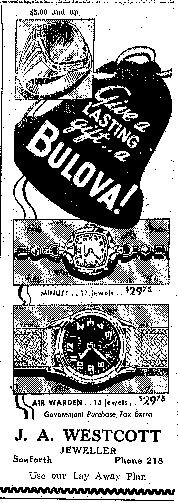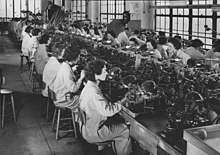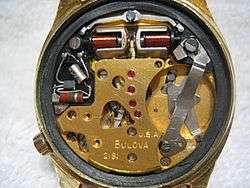Bulova
Bulova is an American watch brand founded in 1875 and currently owned by Japanese conglomerate Citizen Watch Co. It manufactures watches and clocks and is based in New York City.[2] Bulova's Swiss-Made line is known as Bulova Accu•Swiss and was formerly known as Bulova Accutron.
 | |
| Subsidiary of Citizen Watch | |
| Industry | Film Watch and clockmaking |
| Predecessor | J. Bulova Company |
| Founded | Queens, New York City, United States (1875) |
| Founder | Joseph Bulova |
| Headquarters | , United States |
Area served | Worldwide |
Key people | Jeffrey Cohen, President John Wille, Chief Financial Officer |
| Products | Bulova, Bulova Accu•Swiss, Caravelle, Wittnauer, Clocks |
| Revenue | US$ 164 million (2013)[1] |
| Parent | Citizen Watch |
| Website | bulova.com |
History
Bulova was founded and incorporated as the J. Bulova Company in 1875 by Bohemian immigrant Joseph Bulova.[3] It was reincorporated under the name Bulova Watch Company in 1923, and became part of the Loews Corporation in 1979[4] and sold to Citizen at the end of 2007.[5]
In 1912, Joseph Bulova launched his first plant dedicated entirely to the production of watches. Manufacturing watches at their factory in Biel (Switzerland), he began a standardized mass production new to watchmaking. In 1919, Bulova offered the first complete range of watches for men. The visual style of his first popular advertising made its watches popular with the American public. But beyond the original style, precision and technological research also became imperative for Bulova. In 1927, he set up an observatory on the roof of a skyscraper located at 580 5th Avenue to determine universal time precisely.
Bulova established its operations in Woodside, New York, and Flushing, New York, where it made innovations in watchmaking, and developed a number of watchmaking tools.[4] Its horological innovations included the Accutron watch, which used a resonating tuning fork as a means of regulating the time-keeping function.

Bulova became a renowned watch company in 1923. Bulova produced the first advertisement broadcast on radio in 1926, announcing the first beep of history: ‘At the tone, it’s eight o’clock, Bulova Watch Time’, an announcement heard by millions of Americans. In 1927, Charles A. Lindbergh became the first solo pilot to cross the Atlantic nonstop. His crossing earned him a Bulova Watch and a check for $1000, and it became an emblem for the brand that created the model "Lone Eagle" in his likeness. Bulova claims to have been the first manufacturer to offer electric clocks beginning in 1931, but the Warren Telechron Company began selling electric clocks in 1912, 19 years prior to Bulova. In the 1930s and 1940s, the brand was a huge success with its rectangular plated watches whose case was strongly curved to better fit the curve of the wrist.

Bulova produced the world's first television advertisement, on July 1, 1941 (the first day that commercial advertising was permitted on television), before a baseball game between the Brooklyn Dodgers and Philadelphia Phillies over New York station WNBT (now WNBC). The announcement, for which the company paid anywhere from $4.00 (equivalent to $70 in 2019) to $9.00 (equivalent to $156 in 2019), displayed a WNBT test card modified to look like a clock with the hands showing the time. The Bulova logo, with the phrase "Bulova Time", was shown in the lower right-hand quadrant of the test pattern while the second hand swept around the dial for one minute.[6][7]
In the 1940s, Bulova made a few examples of their complex four sided, five-dial per side "sports timer" analog game clock[8] for use in NHL pro ice hockey games and for the nascent NBA pro basketball league of that time. They were put in indoor sports arenas such as Boston Garden, Chicago Stadium and the Detroit Olympia. The last example was taken out of service in Chicago in 1976, all replaced by digital-display game timepieces.[9]
In 1945, Arde Bulova, Chairman of the Board, founded the Joseph Bulova School of Watchmaking to provide training for disabled veterans after the Second World War. The school later became a full-fledged rehabilitation facility, an advocate for disabled people nationwide, and one of the founders of wheelchair sports in the United States. The school closed in 1993.
In 1967, Bulova bought the Manufacture des Montres Universal Perret Frères SA at Geneva and sold it in December 1977. The factory in Biel was closed in 1983.
Accutron

Bulova’s "Accutron" watches, first sold in October 1960,[10] use a 360 Hz tuning fork instead of a balance wheel as the timekeeping element.[11] The inventor, Max Hetzel, was born in Basel, Switzerland, and joined the Bulova Watch Company in 1948.[11] The tuning fork was powered by a one-transistor electronic oscillator circuit, so the Accutron qualifies as the second "electronic watch", following the Hamilton Electric released in 1957. Instead of the ticking sound made by mechanical watches, the Accutron had a faint, high-pitched hum which came from the vibrating tuning fork. A forerunner of modern quartz watches which also keep time with a vibrating resonator, the Accutron was guaranteed to be accurate to one minute per month, or two seconds per day, considerably better than mechanical watches of the time.[11]
Space
In the 1960s, the company was involved in a rivalry with Omega Watches to be selected as the 'first watch on the Moon'. In 1971, a Bulova chronograph was carried on board Apollo 15—the fourth mission to land men on the Moon—by mission commander David Scott. All twelve men who walked on the Moon wore standard Omega Speedmaster watches that had been officially issued by NASA. Those watches are deemed to be government property. Transcripts from the Apollo 15 Lunar Surface Journal attest to the fact that during Scott's second excursion on the Moon's surface, the crystal face on his Omega watch had popped off.[12] So, during his third lunar walk, he used his backup Bulova watch. The Bulova Chronograph Model #88510/01 that Scott wore on the lunar surface was expected to fetch more than $1 million, as it is the only privately owned watch to have been worn while walking on the lunar surface. There are images of him wearing this watch, when he saluted the American flag on the Moon, with the Hadley Delta expanse in the background. The watch shows "significant wear from exposure while on the Moon, and from splashdown and recovery." The watch sold for $1.625 million, which makes it the most expensive astronaut-owned artifact ever sold at auction.[13] The watch is also a unique timepiece as it seems to have been a prototype, only revealed by Scott to Bulova´s fans in 2014 [14]. Therefore, the company released a homage edition of the lunar watch in early 2016, using a modern high frequency quartz movement for the watch that took more than 40 years to make its way into production line. [15] )
Present day
On January 10, 2008, Citizen bought the Bulova Watch Company for $250 million.
Currently Bulova designs, manufactures, and markets several different brands, including: the signature "Bulova", the stylish "Caravelle" (formerly "Caravelle New York"), the dressy/formal Swiss-made "Wittnauer Swiss", and the "Marine Star". In 2014 Bulova ceased the sale of watches under the "Accutron" and "Accutron by Bulova" brand, eliminating some Accutron models and subsuming others under the "Bulova" brand.
In 2010, Bulova introduced the Precisionist, a new type of quartz watch with a higher frequency crystal (262144 Hz, eight times the industry standard 32768 Hz) which is claimed to be accurate to ±10 seconds per year (0.32 ppm) and has a smooth sweeping second hand rather than one that jumps each second.[16]
See also
- Electric watch
- Hamilton Watch
References
- "Bulova Corporation". InsideView. InsideView, Inc. Archived from the original on 2013-12-01. Retrieved 1 December 2013.
- "Contact Us". Bulova Corporation. Retrieved 13 September 2009.
- Birth record: Joseph Bulova. Retrieved September 5, 2019
- Kenneth T. Jackson (1995). The Encyclopedia of New York City. The New York Historical Society. Yale University Press. p. 168.
- Citizen to buy watchmaker Bulova from Loews, Reuters news agency, 4 October 2007, retrieved 14 December 2013.
- Stewart, RW (July 6, 1941), "Imagery For Profit", The New York Times.
- WNBT/Bulova test pattern (JPEG), Early television.
- Arena clock (JPEG), Rireds.
- Fenway (March 2, 2012). "What season was this clock retired?". HF Boards. Retrieved December 25, 2013.
- "History", About, Bulova.
- Day, Lance; McNeil, Ian (2013). "Hetzel, Max". Biographical Dictionary of the History of Technology. Routledge. p. 597. ISBN 1-13465020-5.
- Roberta, Naas (2015-10-23). "Bulova Chronograph Worn by Astronaut Dave Scott on the Moon Sells for $1.6 Million". Forbes. Retrieved 2019-07-02.
- "Astronaut's watch worn on the moon sells for record $1.6 million | collectSPACE". collectSPACE.com. Retrieved 2017-02-07.
- "Bulova Chronograph Flown to moon on Apollo 15". mybulova.com. Retrieved 2020-07-19.
- "HOW BULOVA USED A UNIVERSAL GENÈVE TO GET TO THE MOON, AND HOW YOU CAN GET ONE TODAY". wornandwound.com. Retrieved 2017-02-07.
- "Bulova introduces the most accurate watch in the world, the Precisionist". Crunch gear. 2010-03-23. Retrieved 2012-07-08.